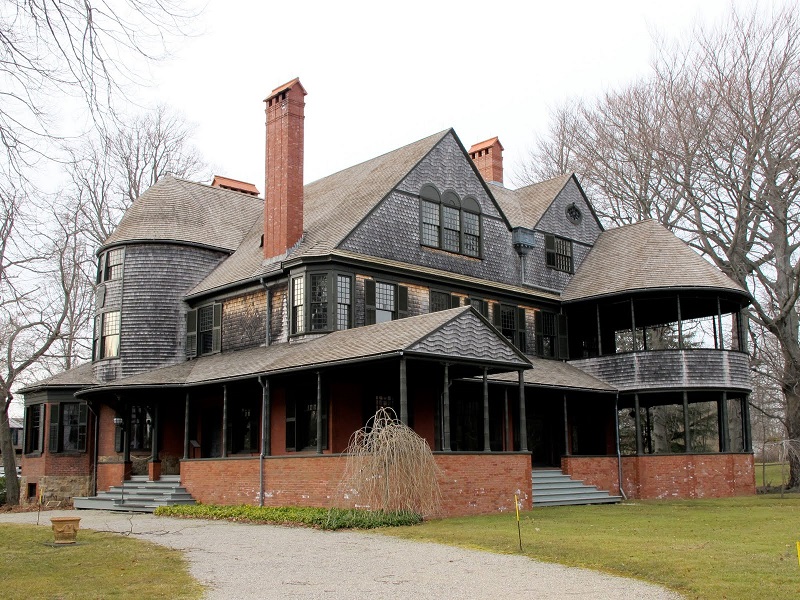Shingle style architecture
The Shingle style was employed between 1880 and 1900 by prominent American architects like H.H. Richardson, Frank Lloyd Wright and the firm of McKim, Meade, and White. The Shingle style is sometimes referred to as an outgrowth of the Queen Anne style as influenced by the early shingled buildings of New England colonies.
The style began in the New England region and some of the earliest and most notable examples are located there. The Shingle style spread throughout the country, but never became as popular or prevalent as the Queen Anne style. It remained a high fashion, architect-designed style that was seldom translated into more vernacular housing use.
The Shingle style house is marked by the presence of shingles on not just the roof, but on the wall surfaces themselves. The first floor walls may be shingled, or of stone or brick. Shingles may also cover gable ends, curving towers and porch columns.
Shingle style buildings have a rather monochrome appearance since the shingles are unpainted and uniformly cover most exterior surfaces. In shape and form, the Shingle style resembles the Queen Anne style, but it lacks the abundant decorative details. Porches are expansive, often wrapping around the front and sides of the building. Roofs are generally sweeping and multi-gabled. Windows are small and multi-paned and are often grouped in pairs or triples.
The most identifiable features of shingle style architecture include:
- Shingled walls and roof.
- Asymmetrical façade.
- Irregular roof lines.
- Moderately pitched roofs.
- Cross gables.
- Extensive wide porches.
- Small sash or casement windows with many panes.
- Round or polygonal shingled towers.
This article was written by PHMC.
--Pennsylvania Historical and Museum Commission
See also: Shingle roofing.
NB The 2018 International Residential Code (IRC), published by the International Code Council (ICC) defines shingle fashion as: ‘A method of installing roof or wall coverings, water-resistive barriers, flashing or other building components such that upper layers of material are placed overlapping lower layers of material to provide drainage and protect against water intrusion at unsealed penetrations and joints or in combination with sealed joints.’
[edit] Related articles on Designing Buildings Wiki
- Architectural styles.
- Arts and craft movement.
- Balloon framing.
- Beaux Arts style.
- Bungalow.
- Chateauesque style.
- Classical Revival style.
- Frank Lloyd Wright.
- Nineteenth century architecture.
- Octagon style.
- Prairie School style.
- Rule of thumb.
- Shingle roofing.
- Spanish Colonial revival style.
- Stick style.
- Tudor Revival style.
Featured articles and news
RTPI leader to become new CIOB Chief Executive Officer
Dr Victoria Hills MRTPI, FICE to take over after Caroline Gumble’s departure.
Social and affordable housing, a long term plan for delivery
The “Delivering a Decade of Renewal for Social and Affordable Housing” strategy sets out future path.
A change to adoptive architecture
Effects of global weather warming on architectural detailing, material choice and human interaction.
The proposed publicly owned and backed subsidiary of Homes England, to facilitate new homes.
How big is the problem and what can we do to mitigate the effects?
Overheating guidance and tools for building designers
A number of cool guides to help with the heat.
The UK's Modern Industrial Strategy: A 10 year plan
Previous consultation criticism, current key elements and general support with some persisting reservations.
Building Safety Regulator reforms
New roles, new staff and a new fast track service pave the way for a single construction regulator.
Architectural Technologist CPDs and Communications
CIAT CPD… and how you can do it!
Cooling centres and cool spaces
Managing extreme heat in cities by directing the public to places for heat stress relief and water sources.
Winter gardens: A brief history and warm variations
Extending the season with glass in different forms and terms.
Restoring Great Yarmouth's Winter Gardens
Transforming one of the least sustainable constructions imaginable.
Construction Skills Mission Board launch sector drive
Newly formed government and industry collaboration set strategy for recruiting an additional 100,000 construction workers a year.
New Architects Code comes into effect in September 2025
ARB Architects Code of Conduct and Practice available with ongoing consultation regarding guidance.
Welsh Skills Body (Medr) launches ambitious plan
The new skills body brings together funding and regulation of tertiary education and research for the devolved nation.
Paul Gandy FCIOB announced as next CIOB President
Former Tilbury Douglas CEO takes helm.
UK Infrastructure: A 10 Year Strategy. In brief with reactions
With the National Infrastructure and Service Transformation Authority (NISTA).
























